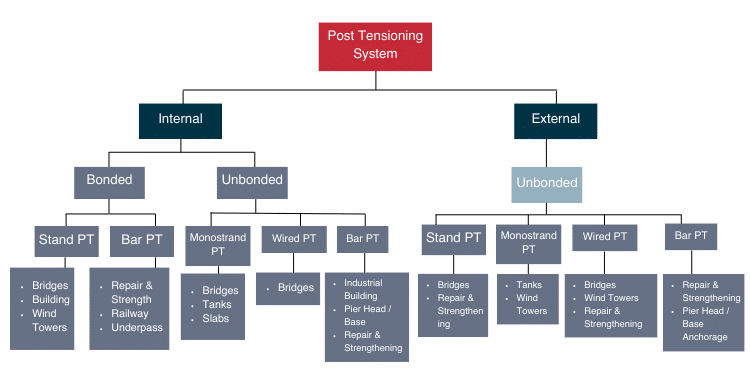AV Infratech Structural Systems Specialists in Post Tensioning
Concept of Post Tensioning

Post-tensioning is a construction technique used to reinforce concrete structures, such as beams, slabs, and columns. It involves the use of high-strength steel strands or cables that are tensioned after the concrete has been poured and cured. The process of post-tensioning provides several advantages over traditional reinforcement methods, such as increased strength, reduced cracking, and improved structural performance.
To make sure the strength and durability of the whole process, these are the materials that are used during the Post-Tensioning Process:
In post-tensioning, the concrete gains strength faster, allowing the formwork or shuttering to be removed at an earlier stage compared to traditional construction methods. This speeds up the construction process and reduces overall construction time.
Post-tensioning offers more flexibility in accommodating service ducts (such as electrical or plumbing conduits) and false ceilings within the structure. The absence of beams and larger column-free spaces created by post-tensioning make it easier to install and arrange these services, providing greater design freedom and adaptability.
Post-tensioning eliminates the need for traditional beams, resulting in larger column-free spaces within the building. This opens up possibilities for various interior design layouts, providing more flexibility in space utilization and enhancing the aesthetics of the structure.
Post-tensioning uses high-strength steel tendons or cables that are tensioned after the concrete has hardened. These tendons help bear the load, reducing the need for additional reinforcement. As a result, the overall quantity of reinforcement required is reduced, leading to cost savings and more efficient structural design.
Post-tensioning enables a significant reduction in the weight of the building compared to a conventional concrete structure with the same number of floors. This reduction in weight reduces the load on the foundation, making it advantageous, especially in seismic areas where lower foundation loads can improve the structure’s resilience to earthquakes.
Post-tensioning helps minimize the occurrence of cracks in the concrete structure. The pre-stressing forces applied through the tendons compress the concrete, reducing tensile stresses and mitigating crack formation. This results in a more durable and crack-resistant structure.
Post-tensioned concrete exhibits superior durability against freezing and thawing cycles compared to non-prestressed concrete. The compressive forces introduced by post-tensioning help resist the expansion and contraction of the concrete due to temperature variations, enhancing its resistance to damage caused by freezing and thawing.
Post-tensioning is commonly used in the construction of parking structures due to its benefits. It allows for a high degree of flexibility in column layout, longer span lengths, and ramp configurations, making it the preferred system for designing and constructing parking facilities. This flexibility enables efficient space utilization and optimal design solutions.
Post-tensioning provides enhanced flexibility for accommodating penetrations and openings in floors, both during and after construction. The absence of traditional beams and larger column-free spaces make it easier to incorporate penetrations and openings, allowing for more adaptable and customizable design solutions.
